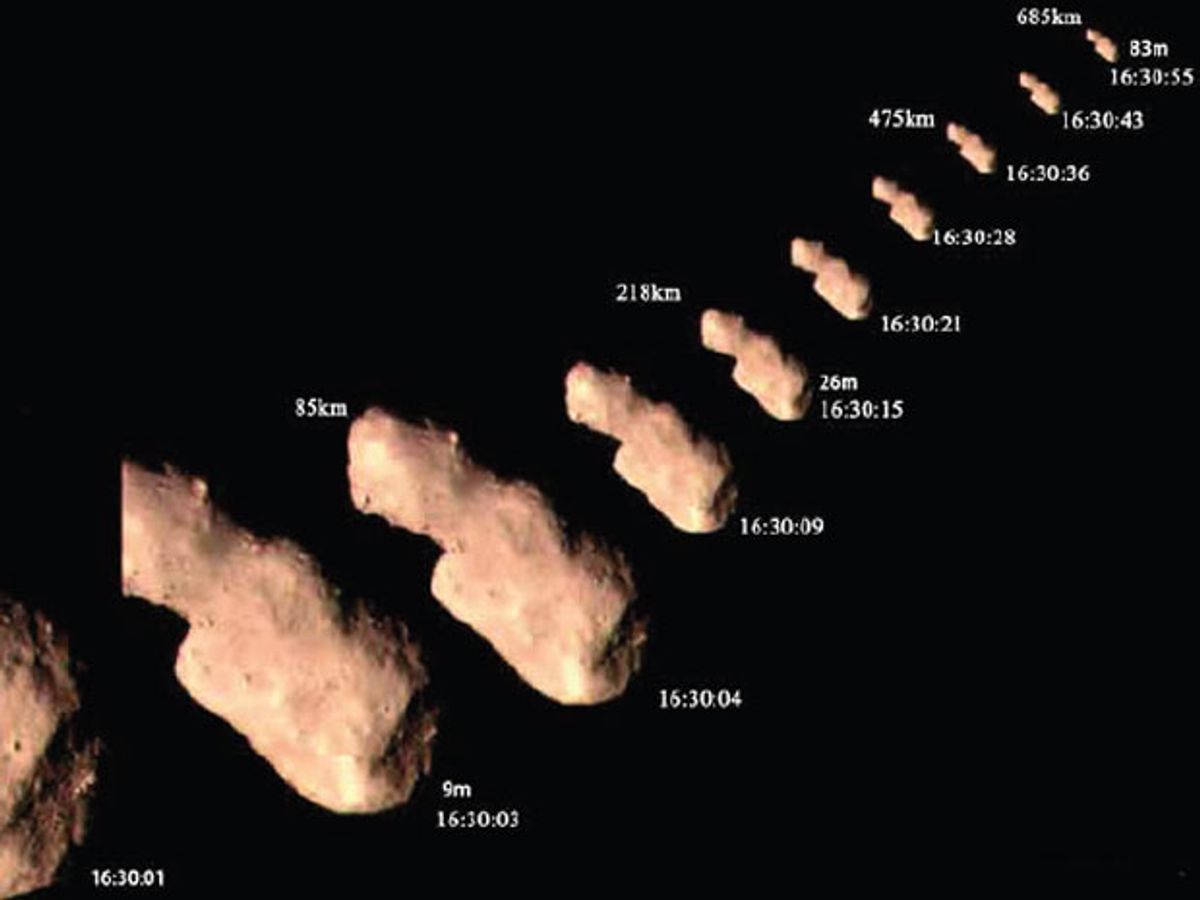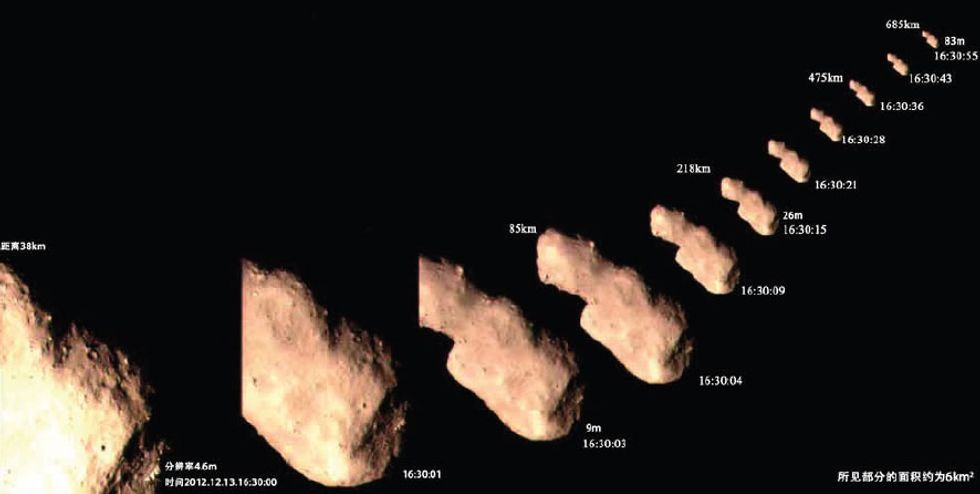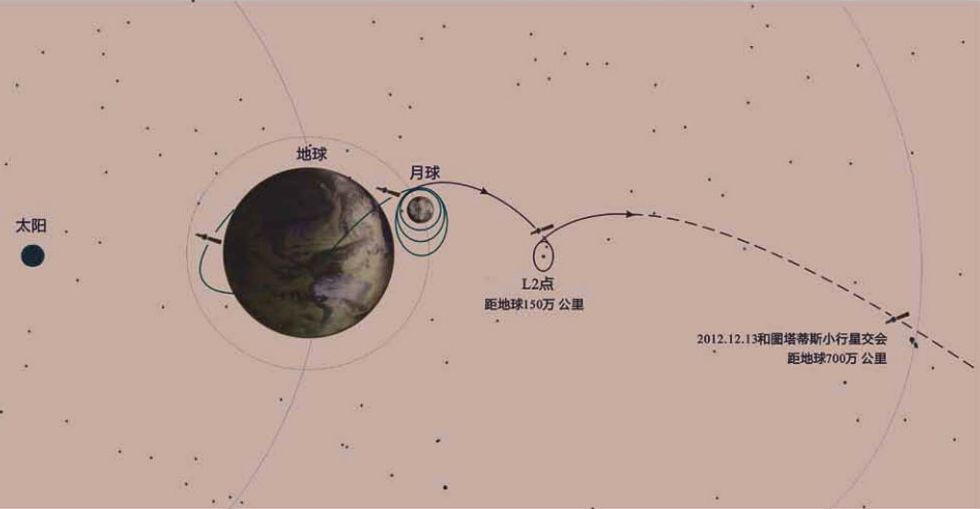A Chinese scientist speaking at an astronomy conference in Washington last week cleared up some of the mystery surrounding China’s first foray into interplanetary space.
A month ago, China enjoyed a spectacular success as its Chang’e-2 satellite flew past the asteroid Toutatis and sent close-up images back to Earth. The project demonstrated innovative mission flexibility as well as intricate virtuosity in deep-space navigation. Most impressive of all is that when the spacecraft was launched in 2010, the asteroid flyby was not, and had never been, part of its flight plan.
Details of the probe’s encounter had been strangely hard to come by, but on 15 January, a Chinese space official finally opened up. Speaking at a meeting of the Small Bodies Assessment Group, which specializes in asteroids, comets, and small moons, the scientist discussed the probe’s recent achievements and future plans.
Han Li of China’s National Astronomical Observatories delivered a report [PDF], coauthored with Chunlai Li from the National Astronomical Observatories at the Chinese Academy of Sciences, that showed that the Toutatis mission’s scientific agenda had been modest but eminently respectable, say scientists at the gathering.
Chang’e-2 launched in October 2010 and was China’s second moon orbit mission. A modified geosynchronous satellite bus with an impressive array of imagers and other scientific instruments, the probe circled the moon for six months and completed its mapping task perfectly. But it had a lot of propellant and vehicle lifetime left.
Of several possible extended missions, officials chose a slow transfer to the Sun-Earth Lagrange Point 2 (SEL-2). This region of space, about four lunar distances “down sun” of Earth, is a quasi-stable-gravity environment where several other science satellites have been stationed to give them uninterrupted views of the stars. It’s where NASA’s delayed and overbudget James Webb Space Telescope will someday be deployed.
But the region is also considered a “dynamic gateway” to interplanetary flight. In theory, it is a location where vehicles can be assembled, fueled, and then efficiently dispatched toward other planets. And after a year at drift there, Chang’e-2 followed that flight profile exactly.
Because of previous high-precision radar observations, the target asteroid’s orbit was exceptionally well charted. Chang’e-2’s flight path was a slow departure that used little fuel. It stayed within Earth’s orbital plane around the sun, and it was aimed at a point in the plane at which the asteroid Toutatis was expected to pass through.
At that location, the probe would be more than 7 million kilometers from Earth, more than 20 times the distance for which its communication system had been designed. So back on Earth, China rushed to complete two big new radio telescopes that had already been in the works, a 50-meter dish at Miyun and a 40-meter dish at Kunming. Both were on line in time to support the distant encounter.
The added communications capabilities did the trick, but even so, data rates were severely reduced. While in lunar orbit, Chang’e-2 was able to relay digital images at 2 megabits per second, and at the more distant SEL-2 point, it achieved 750 kilobits per second. For the Toutatis encounter, the rate, via the probe’s 0.6-meter high-gain S-band antenna, was down to just 20 kb/s.
That low bit-rate might be the reason for the silence that followed immediately after the probe was set to reach Toutatis. There was no official word for 36 hours following the expected encounter time.
The geometry of the interplanetary encounter made it a major challenge to obtain images of the asteroid. Unlike the repetitive, steady survey orbits of the moon, timed for best sunlight on the lunar surface, the Toutatis encounter had one chance for a fast flyby with a highly varying and not-well-predicted line of sight. And because the asteroid was zooming away from the sun, the side of the asteroid facing the probe was mostly shadowed as Chang’e-2 approached. So the best views would come only after the probe passed it by.
Rather than use its high-resolution lunar-mapping camera, which was designed to operate in “push-broom” mode, scanning a wide swath of the lunar surface as it passed directly below, Chang’e-2’s handlers chose a simpler and more reliable method—a small CMOS camera originally installed only to observe and verify the deployment of the craft’s solar array after launch.
As Han Li described it, the asteroid came into view of the camera at a range of 38 km, several seconds after its closest approach. At first the view of Toutatis was largely blocked by the solar array. But seconds later, when the craft was 90 km from Toutatis, the asteroid had moved out from behind the array, and imaging continued for several more seconds. Because the probe was departing from very close to the target in almost a straight line, all images were of nearly the same aspect.
Exactly how close Chang’e-2 came to Toutatis is still unclear. The first postencounter report placed the flyby range at 3.2 km, which was astonishingly—even recklessly—tight. Passing within a few kilometers of an asteroid only 2 to 3 km in diameter at a speed of 10 730 meters per second and following a 7-million-km journey could be described as either superb shooting or a near disaster. But if the 3.2-km figure is true, it would be another scientific bonanza. At that distance, the asteroid’s weak gravity could have measurably deflected the probe’s flight path, providing unique data on its mass. Together with imagery of its shape, this would have led to important clues about its density and composition. Han Li’s presentation did not confirm the flyby range.
The belated beginning of what is hoped will be a sequence of disclosures about the mission will help establish this probe’s rightful place as a remarkably skillful piece of space navigation and extended-life operations. Just how close it came to Toutatis, and to total disaster, remains of high human interest as well as of scientific importance.
About the Author
James Oberg worked as an aerospace engineer at NASA for 22 years. He switched to journalism in the late 1990s and now makes his living reporting on space for such outlets as Popular Science, NBC News, and IEEE Spectrum. In August 2012, he reported on a test of a flight path to the International Space Station that takes 6 hours instead of two days.
James Oberg is a retired "rocket scientist" in Texas, after a 20+ year career in NASA Mission Control and subsequently an on-air space consultant for ABC News and then NBC News. The author of a dozen books and hundreds of magazine articles on the past, present, and potential future of space exploration, he has reported from space launch and operations centers across the United States and Russia and North Korea.





